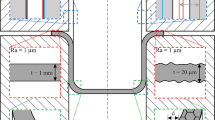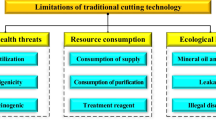Abstract
Electrochemical discharge machining (ECDM) is a non-traditional machining technology used for micromachining of non-conductive materials including glass and ceramics. However, deep micro hole drilling (usually more than 500 μm) always encounters many problems, such as low repeatability, tool bending, and low machining efficiency. All these problems are mainly due to the bubble accumulation on the entrance hole. The phenomenon inhibits the electrolyte to enter the tip of the tool; therefore, the melting conditions will not be satisfied. The recent research shows that gas film formation and the motion of electrolyte are highly influenced by magnetohydrodynamic (MHD) effect. Further, the electrolyte circulation is improved by the MHD effect, and higher machining efficiency can be achieved. However, the poor electrolyte circulation in deep micro hole drilling is still exist, and the machining performance needs to be enhanced. In this paper, a simple, direct strategy for precisely tuning the machining parameters (i.e., supplied voltage and magnetic density) under MHD effect was introduced. Results show that the depth around 1000 μm can be achieved within 100 s with quite good surface quality and even deeper micro hole can be achieved. The method using MHD effect brings a great potential for the development of feedback control algorithms for micro hole machining.









Similar content being viewed by others
Data availability
All data generated or analyzed during this study are included in this published article.
Abbreviations
- Fb :
-
Buoyancy force
- Fs :
-
Surface tension
- Fl :
-
Lorenz force
- ρ g :
-
Density of hydrogen gas
- ρ l :
-
Density of electrolyte
- ρ :
-
Concentration of dissolved hydrogen
- ρ 0 :
-
Bulk flow density of the electrolyte
- \( \overrightarrow{B} \) :
-
Magnetic field
- \( \overrightarrow{I} \) :
-
Current field
- V:
-
Velocity vector of the electrolyte
- D:
-
Diffusion coefficient of the dissolved hydrogen
- n:
-
Electrode normal direction
- z:
-
Discharge number
- F:
-
Faraday constant
- P:
-
Pressure of the electrolyte
References
Kurafuji H, Suda K (1968) Electrical discharge drilling of glass. Ann CIRP 16:415–418
Jain VK, Dixit PM, Pandey PM (1999) On the analysis of the electrochemical spark machining process. Int. J Mach Tools Manuf 39:165–186
Kim DJ, Ahn Y, Lee SH, Kim YK (2006) Voltage pulse frequency and duty ratio effects in an electrochemical discharge microdrilling process of Pyrex glass. Int J Mach Tools Manuf 46:1064–1067
Rajurkar KP, Sundaram MM, Malshe AP (2013) Review of electrochemical and electrodischarge machining. Procedia CIRP 6:13–26
Jiang BY, Lan SH, Wilt K, Ni J (2015) Modeling and experimental investigation of gas film in micro-electrochemical discharge machining process. Int J Mach Tools Manuf 90:8–15
Wüthrich R, Fascio V (2005) Machining of non-conducting materials using electrochemical discharge phenomenon—an overview. Int J Mach Tools Manuf 45:1095–1108
Fascio V, Wüthrich R, Bleuler H (2004) Spark assisted chemical engraving in the light of electrochemistry. Electrochim Acta 49:3997–4003
Jalali M, Maillard P, Wüthrich R (2009) Toward a better understanding of glass gravity-feed micro-hole drilling with electrochemical discharges. J. Micromech. Microeng. 19:045001
Arab J, Kannojia HK, Dixit P (2019) Effect of tool electrode roughness on the geometric characteristics of through-holes formed by ECDM. Precis Eng 60:437–447
Cheng CP, Wu KL, Mai CC, Yang CK, Hsu YS, Yan BH (2010) Study of gas film quality in electrochemical discharge machining. Int J Mach Tools Manuf 50:689–697
Wüthrich R, Hof LA (2006) The gas film in spark assisted chemical engraving (SACE)—A key element for micro-machining applications. Int J Mach Tools Manuf 46:828–835
Sabahi N, Reza MR, Hajian M (2017) Experimental investigation of surfactant-mixed electrolyte into electrochemical discharge machining (ECDM) process. J Mater Process Technol 250:190–202
Wüthrich R, Comninellis CH, Bleuler H (2005) Bubble evolution on vertical electrodes under extreme current densities. Electrochim Acta 50:5242–5246
Hajian M, Razfar MR, Movahed S (2016) An experimental study on the effect of magnetic field orientations and electrolyte concentrations on ECDM milling performance of glass. Precis Eng 45:322–331
Cheng CP, Wu KL, Mai C, Hsu YS (2010) Magnetic field-assisted electrochemical discharge machining. J Micromech Microeng 20:75019–75017
Lin MY, Tsai TH, Hourng LW, Wang WK (2019) The effects of magnetic field and ethanol addition on the electrochemical discharge machining. Int J Adv Manuf Technol 105:2461–2467
Xu Y, Chen JH, Jiang BY, Liu Y, Ni J (2018) Experimental investigation of magnetohydrodynamic effect in electrochemical discharge machining. Int J Mech Sci 142-143:86–96
Xu Y, Chen JH, Jiang BY, Ni J (2018) Investigation of micro-drilling using electrochemical discharge machining with counter resistant feeding. J Mater Process Technol 257:141–147
Maillard P, Despont B, Bleuler H, Wüthrich R (2017) Geometrical characterization of micro-holes drilled in glass by gravity-feed with spark assisted chemical engraving (SACE). J Micromech Microeng 17:1343–1349
Wüthrich R, Hof LA, Lal A, Fujisaki K, Bleuler H, Mandin PH, Picard G (2005) Physical principles and miniaturization of spark assisted chemical engraving (SACE). J Micromech Microeng 15:S268–S275
Liu HB, Pan LM, Huang HJ, Qin QJ, Li PF, Wen J (2015) Hydrogen bubble growth at micro-electrode under magnetic field. J Electro Anal Chem 754:22–29
Funding
This research was supported by the national program for Key S & T project (2014ZX04009021) China, China Postdoctoral Science Foundation Funded Project (No. 2020M672332), and advanced programs of Hubei human resources and technology (No. 016100200). The author also would like to gratefully acknowledge the financial support from China Scholarship Council.
Author information
Authors and Affiliations
Contributions
Yi Xu and Baoyang Jiang conceived the idea. Yi Xu built up the experimental platform and was the major contributor in writing the manuscript. Baoyang Jiang provided valuable suggestions and improved the English writing.
Corresponding author
Ethics declarations
Ethical approval and consent to participate
Not applicable.
Consent for publication
Not applicable.
Conflict of interest
The authors declare that they have no conflict of interest.
Additional information
Publisher’s note
Springer Nature remains neutral with regard to jurisdictional claims in published maps and institutional affiliations.
Rights and permissions
About this article
Cite this article
Xu, Y., Jiang, B. Machining performance enhancement of deep micro drilling using electrochemical discharge machining under magnetohydrodynamic effect. Int J Adv Manuf Technol 113, 883–892 (2021). https://doi.org/10.1007/s00170-021-06657-8
Received:
Accepted:
Published:
Issue Date:
DOI: https://doi.org/10.1007/s00170-021-06657-8




